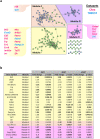Integrated gene expression profiles reveal a transcriptomic network underlying the thermogenic response in adipose tissue
- PMID: 37142619
- PMCID: PMC10160086
- DOI: 10.1038/s41598-023-33367-w
Integrated gene expression profiles reveal a transcriptomic network underlying the thermogenic response in adipose tissue
Abstract
Obesity and type 2 diabetes are two closely related diseases representing a serious threat worldwide. An increase in metabolic rate through enhancement of non-shivering thermogenesis in adipose tissue may represent a potential therapeutic strategy. Nevertheless, a better understanding of thermogenesis transcriptional regulation is needed to allow the development of new effective treatments. Here, we aimed to characterize the specific transcriptomic response of white and brown adipose tissues after thermogenic induction. Using cold exposure to induce thermogenesis in mice, we identified mRNAs and miRNAs that were differentially expressed in several adipose depots. In addition, integration of transcriptomic data in regulatory networks of miRNAs and transcription factors allowed the identification of key nodes likely controlling metabolism and immune response. Moreover, we identified the putative role of the transcription factor PU.1 in the regulation of PPARγ-mediated thermogenic response of subcutaneous white adipose tissue. Therefore, the present study provides new insights into the molecular mechanisms that regulate non-shivering thermogenesis.
© 2023. The Author(s).
Conflict of interest statement
The authors declare no competing interests.
Figures






References
Publication types
MeSH terms
Substances
LinkOut - more resources
Full Text Sources
Medical
Molecular Biology Databases

